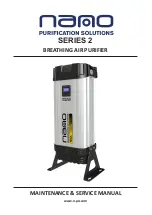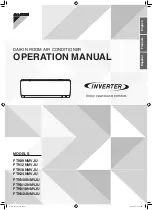
35
Table 6 – Detector Indicators
CONTROL OR INDICATOR
DESCRIPTION
Magnetic test/reset switch
Resets the sensor when it is in the alarm or trouble state. Activates or tests the sensor when it is in
the normal state.
Alarm LED
Indicates the sensor is in the alarm state.
Trouble LED
Indicates the sensor is in the trouble state.
Dirty LED
Indicates the amount of environmental compensation used by the sensor
(flashing continuously = 100%)
Power LED
Indicates the sensor is energized.
Resetting Alarm and Trouble Condition Trips:
Manual reset is required to restore smoke detector systems
to Normal operation. For installations using two sensors,
the duct smoke detector does not differentiate which
sensor signals an alarm or trouble condition. Check each
sensor for Alarm or Trouble status. Clear the condition
that has generated the trip at this sensor. Then reset the
sensor by pressing and holding the reset button (on the
side) for 2 seconds. Verify that the sensor’s Alarm and
Trouble LEDs are now off. At the controller, clear its
Alarm or Trouble state by pressing and holding the
manual reset button (on the front cover) for 2 seconds.
Verify that the controller’s Alarm and Trouble LEDs are
now off. Replace all panels.
Troubleshooting
Controller’s Trouble LED is On
1. Check the Trouble LED on each sensor connected to
the controller. If a sensor’s Trouble LED is on, deter-
mine the cause and make the necessary repairs.
2. Check the wiring between the sensor and the con-
troller. If wiring is loose or missing, repair or replace
as required.
Controller’s Trouble LED is Flashing
1. One or both of the sensors is 100% dirty.
2. Determine which Dirty LED is flashing then clean
that sensor assembly as described in the detector
cleaning section.
Sensor’s Trouble LED is On
1. Check the sensor’s Dirty LED. If it is flashing, the
sensor is dirty and must be cleaned.
2. Check the sensor’s cover. If it is loose or missing, se-
cure the cover to the sensor housing.
3. Replace sensor assembly.
Sensor’s Power LED is Off
1. Check the controller’s Power LED. If it is off, deter-
mine why the controller does not have power and
make the necessary repairs.
2. Check the wiring between the sensor and the con-
troller. If wiring is loose or missing, repair or replace
as required.
Controller’s Power LED is Off
1. Make sure the circuit supplying power to the con-
troller is operational. If not, make sure JP2 and JP3
are set correctly on the controller before applying
power.
2. Verify that power is applied to the controller’s supply
input terminals. If power is not present, replace or re-
pair wiring as required.
Remote Test/Reset Station’s Trouble LED Does
Not flash When Performing a Dirty Test, but the
Controller’s Trouble LED Does
1. Verify that the remote test/station is wired as shown
in Fig. 41. Repair or replace loose or missing wiring.
2. Configure the sensor dirty test to activate the con-
troller’s supervision relay. See “Changing Sensor
Dirty Test Operation.”
Sensor’s Trouble LED is On, But the Controller’s
Trouble LED is OFF
Remove JP1 on the controller.
PROTECTIVE DEVICES
Compressor Protection
Overcurrent
The compressor has internal linebreak motor protection.
Reset is automatic after compressor motor has cooled.
Overtemperature
Each compressor has an internal protector to protect it
against excessively high discharge gas temperatures. Reset
is automatic.
High Pressure Switch
The system is provided with a high pressure switch
mounted on the discharge line. The switch is
stem
−
mounted and brazed into the discharge tube. Trip
setting is 630 psig
±
10 psig (4344
±
69 kPa) when hot.
Reset is automatic at 505 psig (3482 kPa).
Low Pressure Switch
The system is protected against a loss of charge and low
evaporator coil loading condition by a low pressure switch
located on the suction line near the compressor. The
switch is stem
−
mounted. Trip setting is 54 psig
±
5 psig
(372
±
34 kPa). Reset is automatic at 117
±
5 psig (807
±
34 kPa).
Summary of Contents for 580J D17
Page 81: ...81 APPENDIX IV WIRING DIAGRAMS cont C160042 Fig 73 580J D17 D28 Power Diagram 208 230 3 60 ...
Page 82: ...82 APPENDIX IV WIRING DIAGRAMS cont C160043 Fig 74 580J D17 D28 Power Diagram 460 3 60 ...
Page 83: ...83 APPENDIX IV WIRING DIAGRAMS cont C160044 Fig 75 580J D17 D28 Power Diagram 575 3 60 ...
Page 88: ...88 APPENDIX IV WIRING DIAGRAMS cont C160049 Fig 80 RTU OPEN Wiring Diagram ...
















































